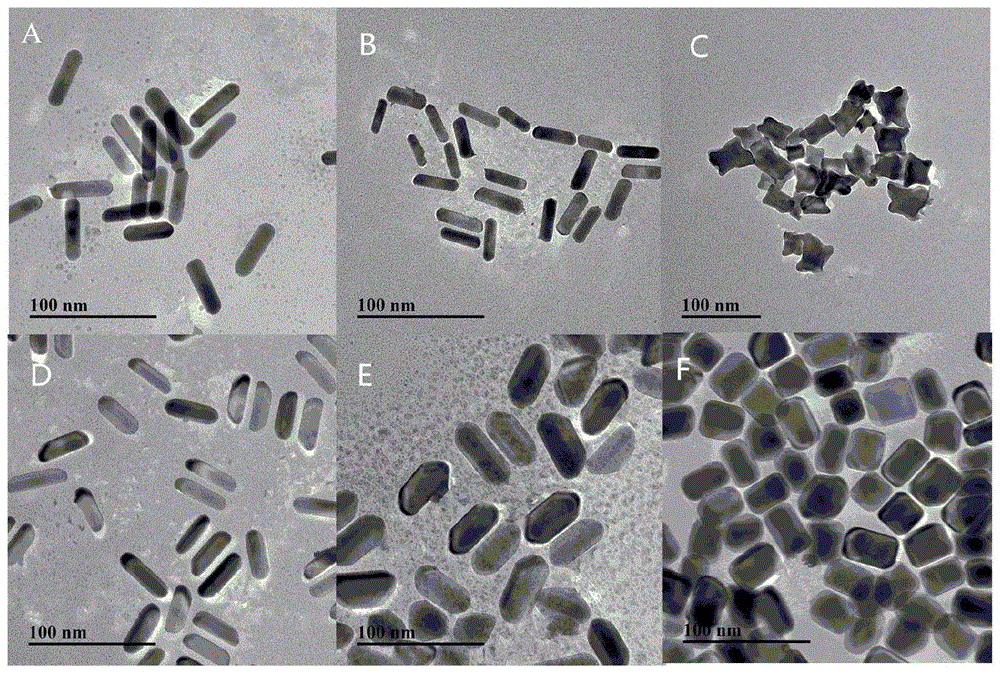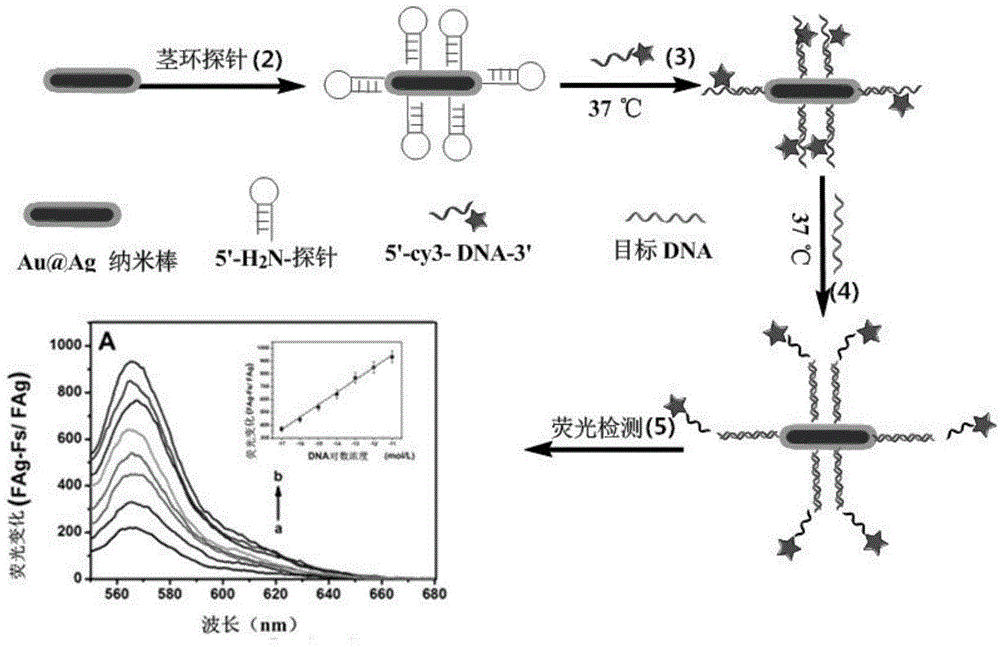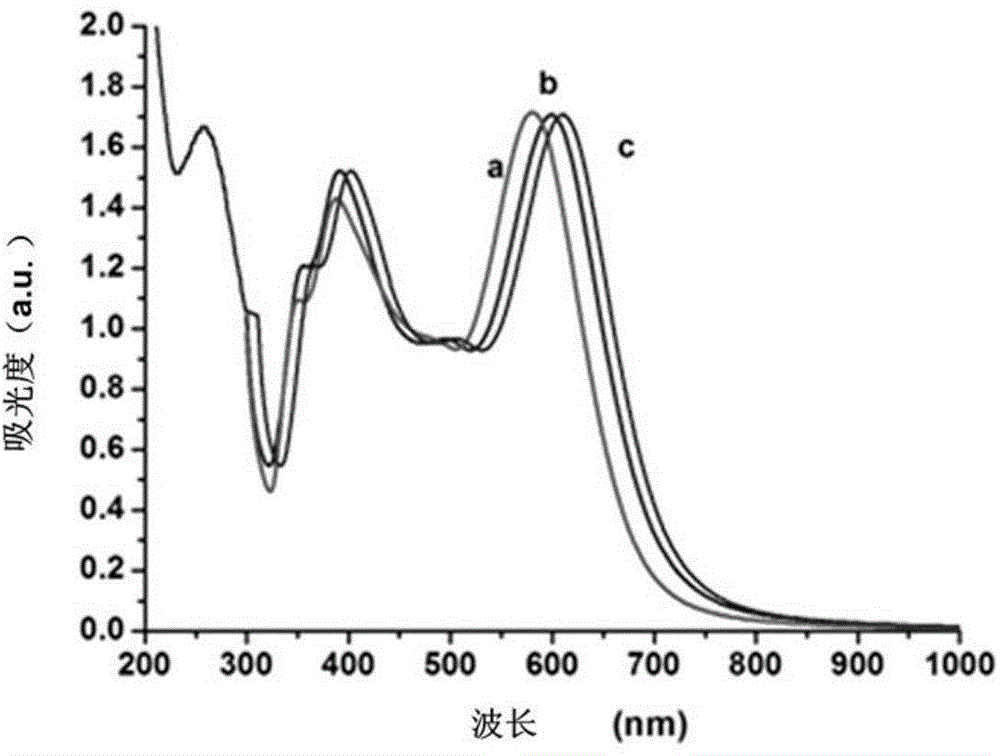Production method of silver-clad gold nano-rods and their application
A technology of gold nanorods and nanorods, which is applied in nanostructure manufacturing, nanotechnology, nanotechnology, etc., can solve the problems of expensive instruments, cumbersome operations, high false positive and false negative rates of PCR, etc., and achieve the aspect ratio distribution Uniform, wide linear range and highly reproducible results
- Summary
- Abstract
- Description
- Claims
- Application Information
AI Technical Summary
Problems solved by technology
Method used
Image
Examples
Embodiment 1
[0040] Synthesis of Example 1 AuAg nanorods
[0041] First, weigh 0.364g CTAB, fully dissolve it in 20mL water, then add 10mL gold nanorod solution to the CTAB aqueous solution under stirring at 27°C, keep stirring for 2min, then add Add 3mM AgNO 3 , 650 μL of 0.1M VC, 1200 μL of 0.1M NaOH, stirring continuously for 5-10 min and standing overnight, the reaction temperature is 27°C.
[0042] Note: Depending on the size of the synthesized AuAg nanorods, choose AgNO 3 The volume of the solution also varies, i.e. the choice of AgNO 3 The volumes of the solutions were 1250 μL, 2500 μL and 3750 μL, respectively.
[0043] figure 1 For Au nanorods and AuAg nanorods TEM (transmission electron microscope image). The present invention has carried out silver-coating experiments on Au nanorods of different lengths (Figures A, B, C), and obtained AuAg nanorods (D, E, F) of different lengths. According to the scale below the figure, through the silver-coating experiments, AuAg nano The...
Embodiment 2
[0044] Example 2 AuAg nanorods used in eaeA gene detection
[0045] Schematic diagram of detection of Escherichia coli O157:H7eaeA gene by AuAg nanorods figure 2 shown. The oligonucleotide probes were modified on the AuAg nanorods, and the fluorescent signal was enhanced after the oligonucleotide probes were hybridized with some nucleotides connected with the fluorescent dye cy3. When the target DNA appears, the probe is combined with the target DNA, and the fluorescence is weakened at this time, so it is applied to the detection of the E. coli O157:H7eaeA gene according to the principle of fluorescence enhancement-decrease.
[0046] The specific method is as follows:
[0047] (1) AuAg nanorod surface modification MUDA
[0048] First, the synthesized AuAg nanorods with a length of 50 nm were centrifuged at 8500 rpm at 25°C, and then, according to the principle of ligand exchange reaction, the surface was modified with mercaptoundecanoic acid (MUDA), and 3 mL of purified Au...
Embodiment 3
[0060] Performance Analysis of Example 3 AuAg Nanorods
[0061] (1) Stability
[0062] Different batches of AuAg nanorods prepared by the present invention were used to detect the eaeA gene of Escherichia coli O157:H7. The results are shown in Table 1. The result shows that the gene recovery rate is 98.36-101.67%, and the error is small, indicating that the AuAg nanorod and the detection method of the present invention have good stability and repeatability.
[0063] Table 1 Detection of Escherichia coli O157:H7eaeA gene recovery rate and error results
[0064]
[0065] Note: This experiment is a recovery experiment, the background concentration is consistent, and the variable is the spiked concentration.
[0066] (2) specificity
[0067] Using the AuAg nanorods prepared in the present invention to detect different gene sequences, including the target sequence completely complementary to the oligonucleotide probe part (5'-CGTCGCGGTATAAGTAATGGTATCGGCGTT-3', that is, as sh...
PUM
| Property | Measurement | Unit |
|---|---|---|
| Length | aaaaa | aaaaa |
| Volume | aaaaa | aaaaa |
| Length | aaaaa | aaaaa |
Abstract
Description
Claims
Application Information
 Login to View More
Login to View More - R&D
- Intellectual Property
- Life Sciences
- Materials
- Tech Scout
- Unparalleled Data Quality
- Higher Quality Content
- 60% Fewer Hallucinations
Browse by: Latest US Patents, China's latest patents, Technical Efficacy Thesaurus, Application Domain, Technology Topic, Popular Technical Reports.
© 2025 PatSnap. All rights reserved.Legal|Privacy policy|Modern Slavery Act Transparency Statement|Sitemap|About US| Contact US: help@patsnap.com



